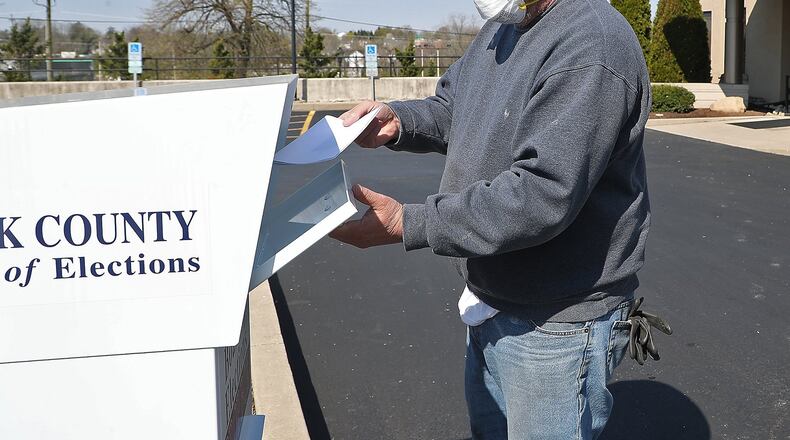Ohio Gov. Mike DeWine and Ohio Department of Health Director Dr. Amy Acton canceled in-person voting on the eve of the March 17 primary election, due to concerns about safety as the coronavirus outbreak spread. The state legislature then changed the election to be all by mail using absentee ballots and rescheduled it to April 28.
Clark County Board of Elections Deputy Director Amber Lopez said the office is experiencing, “a deluge of phone calls and mail.”
“We are doing our best to stay on top of it,” Lopez said. “Our phones are ringing off the hook.”
MORE ELECTION COVERAGE: With voting postponed, Clark County absentee applications rising
A lot of residents voting are voting by mail “for the first time,” Lopez said, and about 14,700 county residents have applied for an absentee ballot, including before the March election.
“So they need an explanation of the process so they how it works.”
Ohio Security of State Frank LaRose said 1.25 million absentee ballots had been requested statewide and 712,048 ballots were cast as of April 10.
“It is absolutely crucial that Ohioans get their vote-by-mail requests in right away so there is enough time for county boards of elections to process applications and the postal service to deliver the ballots,” LaRose said.
The state allocated $7 million to LaRose’s office to reimburse county boards for costs, including prepaid postage, printing, secure ballot boxes, equipment, temporary staff, cleaning supplies and personal protective equipment such as masks.
Baker said the biggest question the board is fielding is, “how do you absentee vote.”
“The voter has to complete an application, and since this is a primary, the voter has to pick a party — either Democratic or Republican —ballot,” Baker said. “Once we get that, we can get the ballot out no problem.”
The board can call a voter to follow up or correct any information that might be on an incomplete ballot, Baker said.
“We can correct almost all of the information we need from a voter via phone call, besides a signature. That really helps the process if we can just call and clear things up,” Baker said. “There is a spot on the application for a phone number. If you don’t fill that out, then we have to send mail and it takes up time for everyone involved.”
MORE ELECTION COVERAGE: Who is running in the 2020 Primary Election in Clark and Champaign County?
Election officials have advised registered voters to mail absentee ballot request forms as soon as possible to give the county time to process the application, mail your ballot and get the ballot back in the mail postmarked no later than April 27. If you have already voted, you should not request another ballot.
In order to cut down on time, voters can drop off both their application and ballot in a dropbox outside of the board, Baker said.
“We check the dropbox multiple times a day. It’s secured,” Baker said. “As far as mailing, if you mail in a ballot it must be dated for the 27th or sooner. On Election Day, ballots can be dropped off until 8 p.m.”
Votes already cast will be counted on April 28. In-person voting will be offered on April 28, but will only occur at boards of elections early voting center and will only be available for people with disabilities who require in-person voting and people who do not have a home mailing address, Baker said.
“To my knowledge, there won’t be a lot of in-person voting on the 28th,” Baker said.
State law allows ballots to be scanned but they cannot be tabulated until 7:30 p.m. April 28. That means election results are likely going to be available much earlier in the evening on election night than in a normal election when the results are collected from polling places across the county, said Aaron Ockerman, director of the Ohio Association of Election Officials.
The legislature made a one-time exception allowing provisional ballots to be cast by mail for people who have moved and not updated their address or who have other special circumstances, Ockerman said.
“We asked the legislature in the name of public health to not make us interact with all those people,” Ockerman said.
Protecting board staff as they interact with the public is one of the key concerns across the state, Ockerman said.
“(Personal protective equipment) is certainly hard to come by for people on the front lines,” Ockerman said, adding that there are also concerns about possible coronavirus contamination of the thousands of pieces of mail elections staff are handling.
Clark County received donated hand-made face masks and has gloves and sanitizing supplies at work stations. For election day the board has fashioned its own sneeze guards for workers in the voting room, Lopez said.

